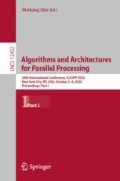Abstract
In this digital age, dramatically developed internet makes the data of complex networks appear an explosive growth, which aggrandizes the importance of multilevel community detection used in large-scale complex networks. Nowadays, there are so many community detection algorithms that could perform well on accuracy. However, none of them has an expected function to handle the time increasing problem which is caused by the inflated network scale. Hence, we propose An Overlapping Community Detection Algorithm based on Triangle Reduction Weighted for Large-scale Complex Network (TRWLPA). It consists of two main steps: 1) Transforming the original network to a small-scale triangle reduction network. This network could not only dramatically reduce the running time of community detection, but recover the original network structure by the inverse transformation. Moreover, the scale of the triangle reduction network could be controlled by setting the iteration times. 2) Doing the multi-label propagation on the reduced networks where the weight of each node is the number of initial nodes it contains. The experiments illustrate that the TRWLPA algorithm significantly reduces the running time of community detection on Youtube, DBLP, and LiveJournal datasets. Particularly, comparing with the MOSES algorithm, it achieves 98.1% running time reduction on the Youtube dataset. Furthermore, our algorithm performs well on both modularity and Normalized Mutual Information measure (NMI).
Access this chapter
Tax calculation will be finalised at checkout
Purchases are for personal use only
References
Blei, D.M., Ng, A.Y., Jordan, M.I.: Latent dirichlet allocation. J. Mach. Learn. Res. 3(Jan), 993–1022 (2003)
Chen, J., Yuan, B.: Detecting functional modules in the yeast protein-protein interaction network. Bioinform. 22(18), 2283–2290 (2006)
Erétéo, G., Gandon, F., Buffa, M.: Semtagp: semantic community detection in folksonomies. In: 2011 IEEE/WIC/ACM International Conferences on Web Intelligence and Intelligent Agent Technology. 1, pp. 324–331. IEEE (2011)
Gregory, S.: Finding overlapping communities in networks by label propagation. New J. Phys. 12(10), 103018 (2010)
Hu, W.: Finding statistically significant communities in networks with weighted label propagation (2013)
Kernighan, B.W., Lin, S.: An efficient heuristic procedure for partitioning graphs. Bell Syst. Tech. J. 49(2), 291–307 (1970)
Kumpula, J.M., Kivelä, M., Kaski, K., Saramäki, J.: Sequential algorithm for fast clique percolation. Phys. Rev. E 78(2), 026109 (2008)
Lee, C., Reid, F., McDaid, A., Hurley, N.: Detecting highly overlapping community structure by greedy clique expansion. arXiv preprint arXiv:1002.1827 (2010)
Liu, X., Li, D., Wang, S., Tao, Z.: Effective algorithm for detecting community structure in complex networks based on GA and clustering. In: Shi, Y., van Albada, G.D., Dongarra, J., Sloot, P.M.A. (eds.) ICCS 2007. LNCS, vol. 4488, pp. 657–664. Springer, Heidelberg (2007). https://doi.org/10.1007/978-3-540-72586-2_95
McDaid, A., Hurley, N.: Detecting highly overlapping communities with model-based overlapping seed expansion. In: 2010 International Conference on Advances in Social Networks Analysis and Mining, pp. 112–119. IEEE (2010)
Newman, M.E.: Fast algorithm for detecting community structure in networks. Phys. Rev. E 69(6), 066133 (2004)
Newman, M.E., Girvan, M.: Finding and evaluating community structure in networks. Phys. Rev. E 69(2), 026113 (2004)
Pizzuti, C.: GA-Net: a genetic algorithm for community detection in social networks. In: Rudolph, G., Jansen, T., Beume, N., Lucas, S., Poloni, C. (eds.) PPSN 2008. LNCS, vol. 5199, pp. 1081–1090. Springer, Heidelberg (2008). https://doi.org/10.1007/978-3-540-87700-4_107
Pizzuti, C.: A multiobjective genetic algorithm to find communities in complex networks. IEEE Trans. Evol. Comput. 16(3), 418–430 (2011)
Raghavan, U.N., Albert, R., Kumara, S.: Near linear time algorithm to detect community structures in large-scale networks. Phys. Rev. E 76(3), 036106 (2007)
Rattigan, M.J., Maier, M., Jensen, D.: Graph clustering with network structure indices. In: Proceedings of the 24th international conference on Machine learning, pp. 783–790 (2007)
Wu, Z.H., Lin, Y.F., Gregory, S., Wan, H.Y., Tian, S.F.: Balanced multi-label propagation for overlapping community detection in social networks. J. Comput. Sci. Technol. 27(3), 468–479 (2012)
Xie, J., Chen, M., Szymanski, B.K.: Labelrankt: incremental community detection in dynamic networks via label propagation. In: Proceedings of the Workshop on Dynamic Networks Management and Mining, pp. 25–32 (2013)
Xie, J., Szymanski, B.K.: Towards linear time overlapping community detection in social networks. In: Tan, P.N., Chawla, S., Ho, C.K., Bailey, J. (eds.) PAKDD 2012. LNCS (LNAI), vol. 7302, pp. 25–36. Springer, Heidelberg (2012). https://doi.org/10.1007/978-3-642-30220-6_3
Xie, J., Szymanski, B.K.: Labelrank: A stabilized label propagation algorithm for community detection in networks. In: 2013 IEEE 2nd Network Science Workshop (NSW), pp. 138–143. IEEE (2013)
Xie, J., Szymanski, B.K., Liu, X.: Slpa: uncovering overlapping communities in social networks via a speaker-listener interaction dynamic process. In: 2011 ieee 11th international conference on data mining workshops, pp. 344–349. IEEE (2011)
Yang, J., Leskovec, J.: Defining and evaluating network communities based on ground-truth. Knowl. Inf. Syst. 42(1), 181–213 (2013). https://doi.org/10.1007/s10115-013-0693-z
Ying, K., Gu, X., Bo, Y., et al.: A multilevel community detection algorithm for large-scale social information networks. Chin. J. Comput. 1, 169–182 (2016)
Yu, X., Yang, J., Xie, Z.Q.: A semantic overlapping community detection algorithm based on field sampling. Expert Syst. Appl. 42(1), 366–375 (2015)
Author information
Authors and Affiliations
Corresponding author
Editor information
Editors and Affiliations
Rights and permissions
Copyright information
© 2020 Springer Nature Switzerland AG
About this paper
Cite this paper
Zhang, H., Dong, B., Feng, B., Wu, H. (2020). An Overlapping Community Detection Algorithm Based on Triangle Reduction Weighted for Large-Scale Complex Network. In: Qiu, M. (eds) Algorithms and Architectures for Parallel Processing. ICA3PP 2020. Lecture Notes in Computer Science(), vol 12452. Springer, Cham. https://doi.org/10.1007/978-3-030-60245-1_43
Download citation
DOI: https://doi.org/10.1007/978-3-030-60245-1_43
Published:
Publisher Name: Springer, Cham
Print ISBN: 978-3-030-60244-4
Online ISBN: 978-3-030-60245-1
eBook Packages: Mathematics and StatisticsMathematics and Statistics (R0)

